In History
Sunday was an incredibly exciting day when Cam Levins broke the 43-year-old Canadian Men’s record, five years after Lanni Marchant broke the 28-year-old Canadian Women’s record. Both records went down with nearly text book conditions at the Scotiabank Toronto Waterfront Marathon. Race Director, Alan Brookes and his Canada Running Series (CRS) team has done an incredible job of taking this race to the next level each and every year. It’s no surprise that both records happened at this race. And we are so grateful that he has invested and believed in Canadian distance runners for so many years. Thank you, Alan and the CRS.
My Own Excitement
While maybe not incredibly exciting, yesterday was pretty special for me for in my own way. After two years I was able to run another marathon in the 2:30’s with my 2:36:46, which also earned me the Canadian bronze medal, World Masters gold medal, and 10th overall placement at my fifth Scotiabank Toronto Waterfront Marathon (STWM). It was also my sixteenth marathon in as many years. I was pretty emotional after seeing my sister, brother and his girlfriend at the finish, and in the post-race media interviews. I am grateful for each and every marathon and will never take the gift of racing 42.2 km for granted. I’m incredibly thankful for the support I’ve received from Saucony for a decade.
My build for this marathon wasn’t anything extraordinary. There was not one “big” workout rather overall depth and consistency like in so many other training blocks. The uneventful build is the most desirable build.
By the Numbers
Similar to my training for third place finish in Boston, I took one complete rest day per week. I averaged a weekly mileage of 151 km over 12 weeks with my highest four weeks at 170, 170, 180 and 190 km. I had nine runs of 34-40 km and routinely ran weekly single 30 km runs around my typical easy pace of just over 5:00 min/km. My marathon paced workouts were ~ 3:38/km, alone on the treadmill or on the road with Mitch Free and Rachel Hannah. My peak treadmill workout was 80′ at 3:35/km within a 40 km run at 3:57/km. Each week Coach Dave Scott-Thomas gave me new interval workouts for speed, and had me complete either strides, hills or 200 m repeats. I did some routine pool running (20-30 min, 2-3x/wk) and strength work (1-2x/wk), physiotherapy and pilates(2x/mo), and massage (1x/mo). I had a regular menstrual cycle every 5 weeks, weighed 124 to 119 pounds, had a resting heart rate of 37-42 beats per minute, and had no injury/illness.

Changing it up
There are three things I did a bit differently this build. Speed River Teammate Reid Coolsaet, who was second Canadian and 10th overall at Sunday’s STWM, has said that it’s always a good idea to add something new to a build and I completely agree.
1. I completed more outside marathon pace workouts, which surprisingly to some who don’t know me, take me out of my treadmill comfort zone. Mitch and Rachel are great friends and training partners and we routinely kept in touch with our progress over the build. Shout out to Dave K. who was a big support with bottles, routes, and words of encouragement on a few long and early Saturday morning runs. After several years of hoping for it, we finally ran most of the STWM together, with each of us happy with our results.
2. In the first two of my three training months I had no restrictions with my diet, didn’t weigh myself, and was fine with feeling a bit heavier, even when racing my half marathons in August at 1:18 and September at 1:17. I knew that with the final peak training weeks followed by tapering and then trimming my intake, that my body would reach an appropriate weight. I know and completely understand that talking about weight and body image is a sensitive topic but also believe that we must keep talking. We must keep the dialogue positive and avoid judgement about what people do or do not eat, do or do not look like, do or do not wear, do or do not weigh.
3. I think I slept better than in any of my other marathon builds, often going to bed around 9:00-10:00 pm and sleeping close to 7:00 am with daily naps of 20 minutes around 1:00 pm.
A Bit More than Before
Another difference in this build was my commitment to coaching my daughter’s rep hockey team. After several years of avoiding activities that could cause injury I decided that after the 2016 Olympics I would start taking risk in order to give back to the community and be more involved in our kids’ lives. Last season when preparing for the 2018 Boston Marathon I was trainer for my daughter’s house league team and routinely on the ice for practices. Knowing I could take a puck off the shin that might end my season was worth the risk. This year was an even bigger next step, running the more frequent practices and building a team that started with only six players in July. It would be a commitment! On the Thursday night I was to leave for the race, I covered half the practice then handed it over in order to catch the GO Train for Toronto. I took my skates, helmet, gloves and stick with me as race weekend would also include filming me for season 2 of CBC’s, “Inside an Athlete’s Head”. Again, I chose to take risk, knowing that even though most of the filming would take place in the two days prior to racing, it was an amazing opportunity and a good career investment. Like my Saucony video, the crew was professional, friendly and personable. I felt comfortable and had a lot of fun with Michael, Shawn, and Coreena as they filmed me speaking at the press conference, skating around the rink at a local hockey arena, going for an easy run by the water, speaking about my athlete thoughts, and racing throughout the entire marathon course. I had been fighting (or in denial about) a bit of a head-cold with a low-grade fever the week of the race, which peaked with a headache on the first day we filmed (Friday). They were a good distraction and with each day I felt better and more encouraged that it wouldn’t have a significant impact on my performance. Stay tuned for more details as it is to air in February 2019.

The Atmosphere
In addition to the filming crew I enjoyed the company of fellow Canadian athletes and event staff as well as international racing friends who made the trip to Toronto to race STWM. Eating meals and visiting with the likes of Australia’s Jess Trengove, and England’s Helen Decker and Hayley Carruthers made for a lovely weekend. Pre-race atmosphere is something that’s important to me and I was delighted to make them feel at home at my hometown and most favourite marathon in the world. Both Jess (2:25:59) and Hayley (2:36:47) set personal bests (PB) and Helen had her second fastest time (2:35:10). I think Toronto will be a special place in their hearts. And I’m sure Alan would gladly welcome them back.
Tested and True
After years of marathoning, I follow the same routine with things like the timing of eating, drinking, and toileting. It’s a big deal when you’re going to be running for 2.5 hours. In the two days before the race I took in ~10 g carb/kg mainly in the form of buns, rice, fruit and potatoes with less than normal fat, fibre and protein. And my pre-race breakfast was my tested and true bagel with honey and 2-3 cups coffee.
Race Day
I felt exactly how I should on race morning — relaxed with a bit of butterflies. The weather was ideal with temperatures slightly above 0 C, a mix of sun and cloud, fairly minimal wind and to my surprise, low humidity. I did a 15-minute warm up jog with Jess T., Natasha W., Kinsey M., Sasha G., and Allie K. and some strides along the start line while taking in the incredible STWM atmosphere that I love so much. The plan was to run around 3:40/km with a goal of ~2:35 and our group with Mitch, Rachel, Helen, a pacer, and several half marathoners kept fairly consistent until around the 21.1 km mark when we started to disperse. It was neat to hear that my friends, Mitch and Helen, perfect strangers to themselves, worked together for the remaining parts of the race. And I was not far behind, just a bit ahead of Rachel, hearing so many people cheer for us along the way. All four of us finished within 2 minutes of each other with Mitch’s PB 2:34:58 and Rachel’s 2:37:09. As for the other Canadian women ahead, I knew Leslie was super fit. With Kinsey debuting, she was more of the wildcard. I’ll be honest, I thought Leslie would likely get the Canadian win and Kinsey might come back to me, but was surprised when at the final turnaround point I saw Kinsey ahead of Leslie. While Leslie was disappointed with her slower than expected 2:36:02, she was able to draw on the positive and was a class act in all of the post-race interviews. Much like Rachel Cliff’s 2:28:53 debut, Kinsey raised eyebrows with her incredible 2:32:09 debut and national title. Way to go, Kinsey!
Back to the Athlete’s Head
I can’t tell you how many times I’ve been asked what I eat or how I train for a marathon. They are easy questions with fairly easy answers. Now what I think about? That’s not so easy to answer. With every marathon I try to not think until the race really starts, sometime after 30 km or so in Boston, with the hills. Marathons never get any easier but with each one you know what to expect, a little bit more. I told myself to keep it relaxed, think about very little, and kept my mind occupied by focusing on my table “F” every 5 km along the way. With every one I grabbed and drank the Eload fluid from my bottle and stored my Endurance Tap gel in my bra, to be consumed in another 2.5 km. I would continue to rotate between the two, every 2.5 km. When it started to get tough on my own with the final 10 km into some wind, all I could think about was “20-0….20-0”, the score of one of our most recent hockey games. Regardless of how much our team was losing lately, our 7 and 8-year-old girls were always giving their all. They wouldn’t back down. Nor would I. The other motivating factor was my goal to make the podium. My bronze in Boston and bronze at our National Championships would make 2018 an incredible year.
The Ride Back
After awards and the press conference, Kinsey and I enjoyed the company of the Levins family with Cam, his lovely wife Elizabeth and parents on the long bus ride back to the hotel. To say they were incredibly pleased with his performance would be an understatement. By getting to know the three of them, you could see why Cam gave credit to his family first and foremost. Truly kind and genuine people. Kinsey and I shared a few good laughs with Cam, who was avoiding turning his phone on because it would quickly use his data, as we showed him the GIFs and social media posts that were quickly popping up after his historic race. Because we were crawling in traffic we decided to get off the bus and walk the remaining distance to our hotel. I had already packed up my belongings so that I could quickly get to Union to catch the GO train back to my van. I thought it was likely impossible but was so happy when I ended the weekend the way it started—back with those 7 and 8-year-old girls playing hockey. I made it back just in time for the third period and had my medals in my pocket that I would share with them after, along with the story of what got me through the tough parts of the race. And after several losses of more than 10 goals per game, we were all smiles with a loss of only 5-2!
The Future
While Cam’s performance was truly epic, breaking the long standing record in his debut marathon, I think it’s safe to say that Canadian women’s marathoning is on fire. The days of it just being Lanni and I, the first two women to run the Olympic Marathon after 20 years, are long gone. Canada has incredible depth with nearly a dozen women running in the high 2:20’s to low 2:40’s. I should add that this includes an age range of women in their 20’s to those of us in our 40’s. There will most certainly be a fight to earn one of the three spots on the Tokyo 2020 team. I am in such a sweet spot to continue taking this marathon journey one race at a time. While making another Olympic team would be a thrill, I’m also content with seeing three other women earn that spot. While I’ve said I have no good reason not to try, I’ll be faced with the difficult decision about which marathon to pick next. Providing an income for my family and aiming for an Olympic standard aren’t really possible in the same marathon. But until then, the only decisions I have to make are whether I will have the butter tart or the pecan square.

Additional photography by Coreena Robertson.
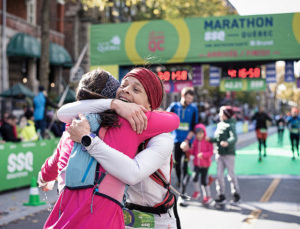
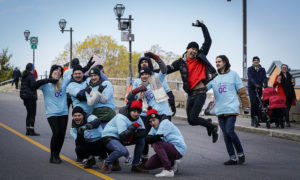












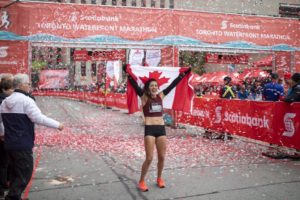

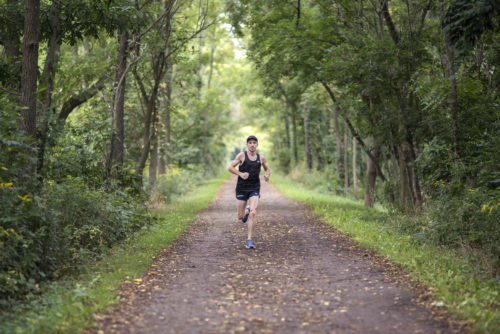
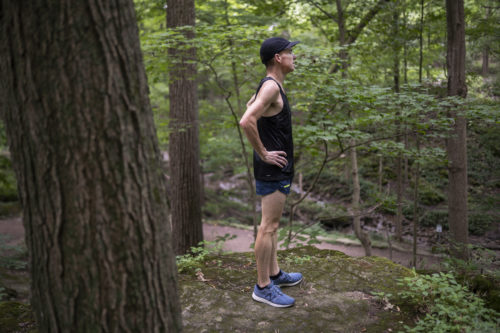

 Our Magazine
Our Magazine
